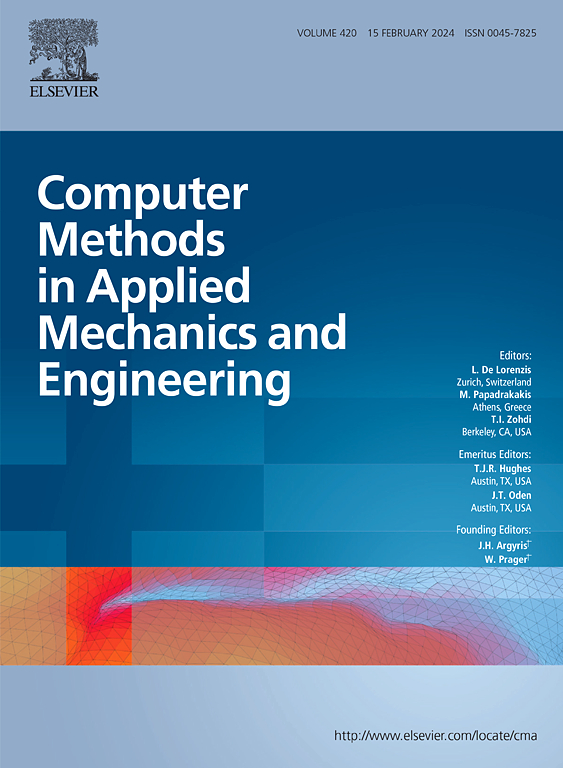Variational formulation based on duality to solve partial differential equations: Use of B-splines and machine learning approximants
IF 6.9
1区 工程技术
Q1 ENGINEERING, MULTIDISCIPLINARY
Computer Methods in Applied Mechanics and Engineering
Pub Date : 2025-04-02
DOI:10.1016/j.cma.2025.117909
引用次数: 0
Abstract
Many partial differential equations (PDEs) such as Navier–Stokes equations in fluid mechanics, inelastic deformation in solids, and transient parabolic and hyperbolic equations do not have an exact, primal variational structure. Recently, a variational principle based on the dual (Lagrange multiplier) field was proposed. The essential idea in this approach is to treat the given PDEs as constraints, and to invoke an arbitrarily chosen auxiliary potential with strong convexity properties to be optimized. On requiring the vanishing of the gradient of the Lagrangian with respect to the primal variables, a mapping from the dual to the primal fields is obtained. This leads to requiring a convex dual functional to be minimized subject to Dirichlet boundary conditions on dual variables, with the guarantee that even PDEs that do not possess a variational structure in primal form can be solved via a variational principle. The vanishing of the first variation of the dual functional is, up to Dirichlet boundary conditions on dual fields, the weak form of the primal PDE problem with the dual-to-primal change of variables incorporated. We derive the dual weak form for the linear, one-dimensional, transient convection–diffusion equation. A Galerkin discretization is used to obtain the discrete equations, with the trial and test functions in one dimension chosen as linear combination of either shallow neural networks with Rectified Power Unit (RePU) activation functions or B-spline basis functions; the corresponding stiffness matrix is symmetric. For transient problems, a space–time Galerkin implementation is used with tensor-product B-splines as approximating functions. Numerical results are presented for the steady-state and transient convection–diffusion equations and transient heat conduction. The proposed method delivers sound accuracy for ODEs and PDEs and rates of convergence are established in the norm and seminorm for the steady-state convection–diffusion problem.
基于对偶性的变分公式求解偏微分方程:使用b样条和机器学习近似
许多偏微分方程(PDEs),如流体力学中的Navier-Stokes方程、固体中的非弹性变形、瞬态抛物方程和双曲方程,都没有精确的原始变分结构。最近,提出了一种基于对偶(拉格朗日乘子)场的变分原理。这种方法的基本思想是将给定偏微分方程视为约束,并调用任意选择的具有强凸性的辅助势来进行优化。在要求拉格朗日函数对原始变量的梯度消失的条件下,得到了对偶到原始域的映射。这就要求在对偶变量的Dirichlet边界条件下对凸对偶泛函进行最小化,并保证即使不具有原始形式的变分结构的偏微分方程也可以通过变分原理求解。对偶泛函的第一次变分的消失,在对偶域上的Dirichlet边界条件下,是包含变量的对偶到原变化的原始PDE问题的弱形式。我们导出了线性一维瞬态对流扩散方程的对偶弱形式。采用Galerkin离散化方法得到离散方程,在一维上选取具有整流功率单元(RePU)激活函数的浅神经网络或b样条基函数的线性组合作为试验和测试函数;相应的刚度矩阵是对称的。对于暂态问题,采用张量积b样条作为近似函数的时空伽辽金实现。给出了稳态、瞬态对流扩散方程和瞬态热传导方程的数值结果。对于稳态对流扩散问题,该方法在L2范数和H1半模下建立了较好的收敛速率。
本文章由计算机程序翻译,如有差异,请以英文原文为准。
求助全文
约1分钟内获得全文
求助全文
来源期刊
CiteScore
12.70
自引率
15.30%
发文量
719
审稿时长
44 days
期刊介绍:
Computer Methods in Applied Mechanics and Engineering stands as a cornerstone in the realm of computational science and engineering. With a history spanning over five decades, the journal has been a key platform for disseminating papers on advanced mathematical modeling and numerical solutions. Interdisciplinary in nature, these contributions encompass mechanics, mathematics, computer science, and various scientific disciplines. The journal welcomes a broad range of computational methods addressing the simulation, analysis, and design of complex physical problems, making it a vital resource for researchers in the field.

 求助内容:
求助内容: 应助结果提醒方式:
应助结果提醒方式:


